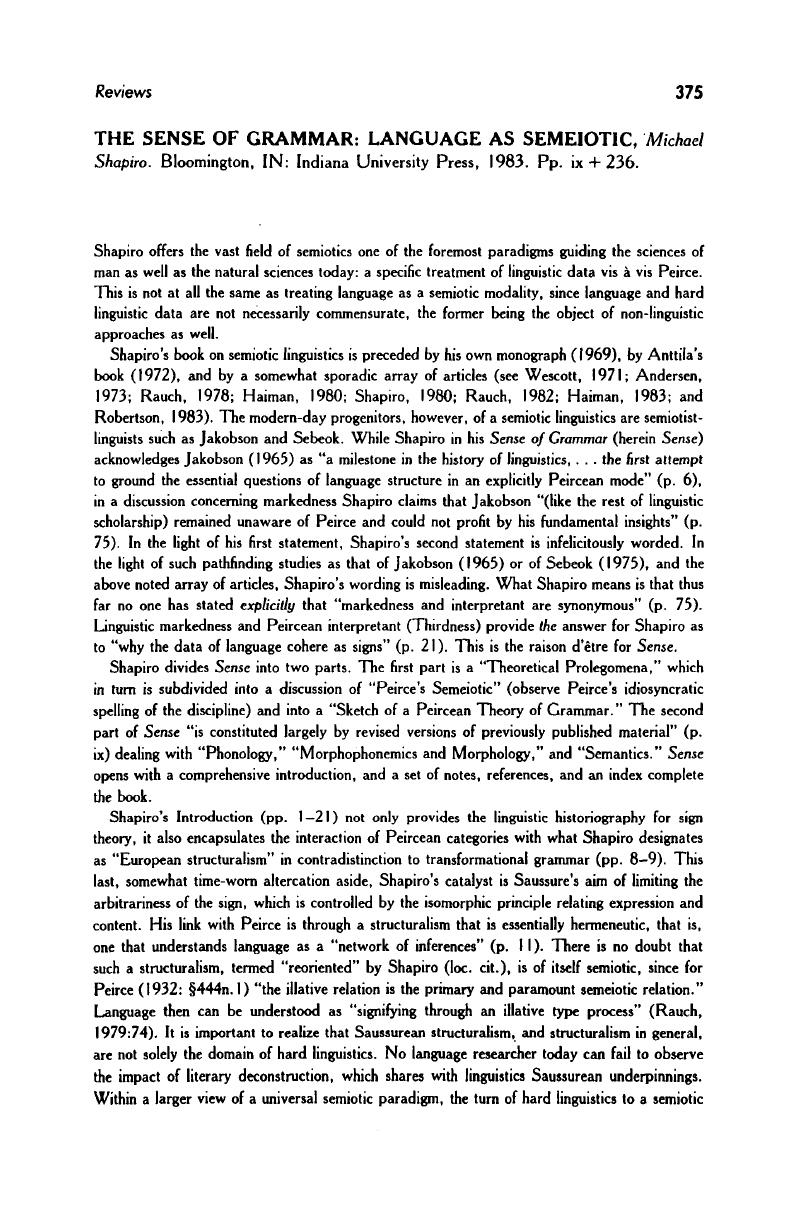No CrossRef data available.
Article contents
THE SENSE OF GRAMMAR: LANGUAGE AS SEMEIOTIC, Michael Shapiro. Bloomington, IN: Indiana University Press, 1983. Pp. ix + 236.
Published online by Cambridge University Press: 07 November 2008
Abstract
An abstract is not available for this content so a preview has been provided. Please use the Get access link above for information on how to access this content.

- Type
- Reviews
- Information
- Copyright
- Copyright © Cambridge University Press 1985
References
REFERENCES
Anttila, R. 1972. An introduction to historical and comparative linguistics. New York: Macmillan.Google Scholar
Haiman, J. 1980. The iconicity of grammar: Isomorphism and motivation. Language 56; 515–40.CrossRefGoogle Scholar
Jakobson, R. 1965. Quest for the essence of language. Diogenes: An international review of philosophy and humanistic studies 51; 21–37.CrossRefGoogle Scholar
Peirce, C. S. 1932. Collected papers of Charla Sanders Peirce, Vol. 2. Hartshorne, C. & Weiss, P., (eds.) Cambridge, MA: Harvard University Press.Google Scholar
Rauch, I. 1978. Distinguishing semiotics from linguistics and the position of language in both. In Bailey, R. (ed.) The sign: Semiotics around the world. Ann Arbor, MI: Department of Slavic Languages and Literatures, University of Michigan.Google Scholar
Rauch, I. 1979. The language-inlay in semiotic modalities. Semiotica 25; 67–76.CrossRefGoogle Scholar
Rauch, I. 1982. Historical analogy and the Peircean categories. In Maher, J. P., Bomhard, A. R., & Koerner, E. F. K. (eds.), Proceedings of the Third International Conference on Historical Linguistics. Amsterdam: Benjamins.Google Scholar
Rauch, I. in press -a. How do Germanic linguistic data react to newer literary methods? In Calder, D. & Christy, C., (eds.), Germania: Comparative studies in lhe Old Germanic languages and literatures. Los Angeles: UCLA Center for Medieval and Renaissance Studies.Google Scholar
Rauch, I. in press -b. Peirce: “With no pretension to being a linguist.” In M. Herzfeld (ed.). Proceedings of the State-of-the-Art Conference. Semiotics: Field or Discipline?Google Scholar
Robertson, J. S. 1983. From symbol to icon: The evolution of the pronominal system from common Mayan to modern Yucatecan. Language 59; 781–819.CrossRefGoogle Scholar
Sebeok, T. A. 1975. The pertinence of Peirce to linguistics. Presidential Address to Linguistic Society of America, San Francisco, December 30.Google Scholar
Shapiro, M. 1969. Aspects of Russian morphology: A semiotic investigation. Cambridge, MA: Slavica.Google Scholar
Shapiro, M. 1980. Russian conjugation: Theory and hermeneutic. Language 56; 67–93.CrossRefGoogle Scholar
Singer, M. 1978. For a semiotic anthropology. In Sebeok, T. A. (ed.), Sight, Sound, and Sense, pp. 202–31. Bloomington: Indiana University Press.Google Scholar




